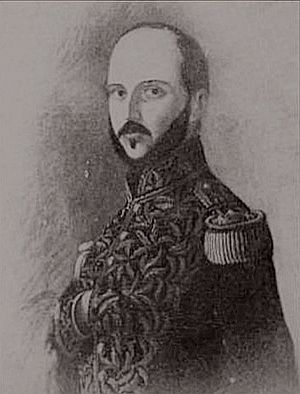Tomás de Herrera facts for kids
Quick facts for kids
Tomás de Herrera
|
|
|---|---|
 |
|
| President of the Free State of the Isthmus* | |
| In office November 18, 1840 – December 31, 1841 |
|
| 12th President of the Republic of the New Granada | |
| In office April 21, 1854 – August 5, 1854 |
|
| Preceded by | José María Melo |
| Succeeded by | José de Obaldía |
| Personal details | |
| Born |
Tomás José Ramón del Carmen de Herrera y Pérez Dávila
December 21, 1804 Panama City |
| Died | December 1, 1854 (aged 49) Bogotá, Cundinamarca |
| Political party | Liberal |
| Spouse | Ramona de Urriola Obarrio |
| Signature |  |
|
|
Tomás de Herrera (born December 21, 1804 – died December 5, 1854) was an important leader and general from a country once called New Granada. Today, this area includes Colombia and Panama.
In 1840, Tomás de Herrera became the leader of the Free State of the Isthmus. This was a short-lived independent country located where Panama is now. Later, in 1854, he also served as the President of the Republic of New Granada. This happened during a time of political unrest.
Herrera began his military career in 1822, becoming a lieutenant. He fought in important battles in Peru against royalist forces. After some challenges, he returned to Panama in 1830. There, he helped fight against Colonel Juan Eligio Alzuru. After this conflict, Herrera was made Colonel Commandant General of the Isthmus of Panama.
In 1840, the people of Panama decided they did not want to join a conflict happening in another region. On November 18, 1840, a meeting in Panama voted for Panama to separate from Colombia. They called their new country the State of the Isthmus, and Colonel Herrera became its president. He worked to set up the new country's economy. He also got Costa Rica and the United States to recognize Panama as an independent nation.
The State of the Isthmus lasted only 13 months. An agreement was made to reunite Panama with Colombia, which Herrera did not support. This union lasted until 1903.
Contents
Tomás de Herrera: Governor of Panama
In 1845, Herrera returned to politics. He became the governor of Panama. Later, he served as the Minister of War and Navy. In 1850, he was appointed governor of Cartagena province. That same year, he earned the rank of general.
In 1851, a revolution started in some provinces against the government. Herrera was appointed to help stop this uprising. He faced Governor Eusebio Borrero, whom he defeated. People saw General Herrera as a very skilled military leader.
How Tomás de Herrera Became President
In 1854, Tomás de Herrera was a member of Congress. The president at the time, José María Obando, was removed from power by a military coup on April 17. The Vice President, José de Obaldía, met with Herrera and others. They tried to figure out how to take control of the government. Obaldía offered Herrera a role as Secretary of War, but Herrera turned it down. He did not want to lose his seat in Congress.
A few days later, Herrera managed to escape the military watch set up by the dictator Melo in Bogotá. On April 21, he reached a town called Chocontá. There, he announced that he was taking over as the acting president. This happened because Obaldía had sent a letter saying he could not form a government.
What Tomás de Herrera Did as President
Herrera quickly appointed Colonel Anselmo Pineda as his Secretary of State. Pineda was in charge of finances, war, and foreign relations. Herrera continued his journey and entered Tunja on April 23. This was possible because Colonel Reyes Patria had secured the city. In Tunja, Herrera appointed General Manuel Maria Franco as the army commander. Reyes Patria became the commander for the provinces of Tunja and Tundama.
General Franco built an army of 2,557 men. Herrera's army left Tunja for Nemocón. They arrived there on May 19. Herrera had to decide between two plans: attacking Colonel Manuel Jimenez's forces or joining forces with General Joaquín París Ricaurte.
Herrera chose to attack Jimenez on May 20, 1854. However, the Battle of Zipaquirá was a defeat for Herrera's forces. After Franco's death, General Marcelo Buitrago took command of the army. Buitrago returned to the battle's starting point, while Herrera went in a different direction to follow his original plan.
With support from another army, Herrera rebuilt his government. He appointed new secretaries for war, foreign affairs, interior, and finance. They tried to join forces with General París but did not succeed. Then, they aimed to reach Ambalema.
At a port, Herrera appointed Tomás Cipriano de Mosquera as commander for Mompós, Panama, and Costa. He also sent instructions to governors. He then traveled to El Guamo, where he met General Lopez and the governor of Cauca. Finally, Herrera reached Ibague and set up the executive branch there. He issued decrees calling lawmakers to meet in Bogotá on July 20.
On July 15, Herrera reorganized his cabinet again. However, on July 20, only 23 congressmen were in Ibague. This was not enough for Congress to officially meet.
Tomás de Herrera's Final Days
On August 5, José de Obaldía officially took over as president. He appointed Herrera as the second-in-command of the army in the North. On September 28, Herrera was leading his troops when General Mosquera, the army's commander-in-chief, visited him. On September 25, they successfully crossed the Chicamocha River. By December 2, they reached the outskirts of Bogotá.
On December 4, 1854, the army attacked the southern side of Bogotá. Herrera led two battalions into action. He was seriously injured during the fighting and died shortly after.
See also
In Spanish: Tomás Herrera para niños

